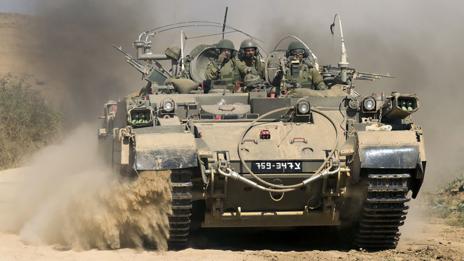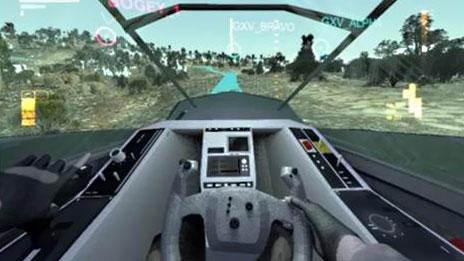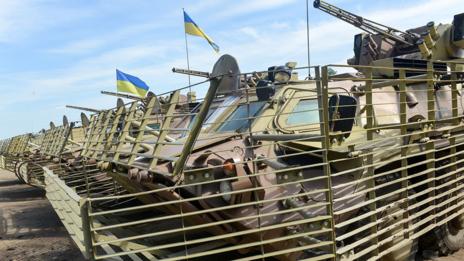Once, heavily armoured military vehicles would trundle into the very heart of battle – the vehicles of the future might adopt a different battlefield strategy.
Your family car, it’s fair to say, doesn’t have much in common with a tank. Military vehicles aren’t required to squeeze into tight parking spots on shopping trips, nor negotiate the traffic jams you encounter on the way to work. But some of the underlying technology in military vehicles does find its way out of the battlefield to end up in your humble hatchback.
Could this be the case for a new type of smart military vehicle? Darpa – the Defense Advanced Research Projects Agency, part of the US Department of Defense – is building machines that will use sensors and artificial intelligence to avoid enemy fire, rather than heavy armour and protection. What the military learns as a result of the Ground X-Vehicle Technology (GXV-T) programme might also make cars that are lighter, smarter, and more efficient.

Modern armoured vehicles rely on thick armour to survive - but this makes them very heavy (Getty Images)
Darpa has been responsible for a number of advances that power our modern lives, including the internet, robotics, and voice recognition. The agency also organised a series of competitions in the period 2004-2007 which were designed to REWARD the development of autonomous driving systems.
the development of autonomous driving systems.
 the development of autonomous driving systems.
the development of autonomous driving systems.
“This is INTERESTING because it is coming full circle,” Jeremy Carlson, a senior analyst at IHS Automotive in the area of advanced driver assist systems says. “A lot of the technology we see in automotive … autonomy came out of the Darpa challenges a few years ago.”
because it is coming full circle,” Jeremy Carlson, a senior analyst at IHS Automotive in the area of advanced driver assist systems says. “A lot of the technology we see in automotive … autonomy came out of the Darpa challenges a few years ago.”
 because it is coming full circle,” Jeremy Carlson, a senior analyst at IHS Automotive in the area of advanced driver assist systems says. “A lot of the technology we see in automotive … autonomy came out of the Darpa challenges a few years ago.”
because it is coming full circle,” Jeremy Carlson, a senior analyst at IHS Automotive in the area of advanced driver assist systems says. “A lot of the technology we see in automotive … autonomy came out of the Darpa challenges a few years ago.”
In the world of military vehicles, the GXV-T’s approach is revolutionary. Instead of lumbering across the battlefield protected by heavy armour, the vehicle’s occupants would be protected by intelligent systems. The object wouldn’t be to avoid being hit, or avoid being penetrated by the shots that do hit: the objective would be to avoid detection and engagement in the first place.
Military rover
“GXV-T’s goal is not just to improve or replace one particular vehicle it’s about breaking the ‘more armour’ paradigm and revolutionising protection for all armoured fighting vehicles,” said Kevin Massey, Darpa programme manager in a statement.
Artists impressions show vehicles that have more in common with a Mars rover than a tank, with a small body supported on four wheels at the end of arms that move independently, allowing the vehicle to scale boulders and other large objects. “It looks like one of those Halo vehicles,” says Scott Aughenbaugh, deputy director for strategic futures at the Center for Strategic and International Studies (CSIS), referencing the futuristic infantry vehicles seen in the shoot-‘em-up gaming classic.
In Darpa’s mock-ups, the vehicle’s interior is hi-tech and streamlined, with a head-up display presenting information directly into the field of view of the driver.

The GXV-T's cockpit wouldn't look out of place in a video game (Darpa)
“It reads to me like they intend to incorporate a number of unmanned advances,” says Maren Leed, a senior advisor at CSIS. That would allow the crew to focus on their mission while the vehicle reaches its destination automatically. It could either be fully autonomous, or it could be ‘remote controlled’ with a degree of autonomy. This is how drones are piloted, from a remote location. A combination of the two would allow one remote pilot to oversee several semi-autonomous tanks, while their occupants are busy spotting potential targets.
The US army is making a big push towards consideration of megacities as possible battlefields of the future, according to Aughenbaugh. “One thing they realise is that sending an Abrams tank down the centre of a street in a disaster area is not easy, so they have to have some smaller lightweight vehicles for some of those places.”
‘Unique challenges’
“So how do you get a tank-like capability in that environment?” asks Leed. “That’s one of their challenges.”
“We have a lot of different applications and sensor technologies upon which these applications are based in automotive,” says Carlson. In reality that means a vehicle that “looks” and “hears” with the help of radar sensors, cameras, laser, reflected light and ultrasound.
“In a very broad sense, yes there are ways that you can apply some of what we’re doing in automotive to other industries, but I also think you face some pretty unique challenges,” he says.

Tanks are difficult to transport becase of their heavy weight (Getty Images)
The US military recognises that in the future they will have to be able to get anywhere in the world, and do it quickly. They will have to do so from US bases, and not rely on being able to build forward bases in other countries, like they’ve done in the past. Current fighting vehicles are too heavy for airlift, and deploying them by sea takes a long time. “Their stated posture is ‘we could have to do anything, so we have to be prepared for everything’,” says Leed.
Increasing the intelligence of a tank to avoid being hit could lead to less armour being required – and that will make it much lighter. It’s much the same advantage argued for driverless cars; if cars are much less likely to crash, then they do not need large crumple zones, or expensive components like multiple airbags and other safety systems.
“Now what we’re looking at is crash avoidance, so that we’re not putting ourselves in those dangerous situations any more,” says Carlson. For military vehicles, being lightweight and small means they can fit into a C-17 transport plane – the current workhorse of the US Air Force – or be slung under a helicopter and dropped into the field.

Darpa believes unwieldy armour could be done away with if vehicles can better 'sense' danger (Getty Images)
“Some of these technologies are available now, some need to be developed more, and they clearly don’t have them all on one platform, which is why they have to build it,” says Aughenbaugh. He is dubious about the project achieving its ambitious 2017 deadline. There are some lessons from history to be considered. We have heard this before, according to Leed, in the ‘Future Combat System’, a US Army modernisation programme in the early 2000s.
“It was ultimately killed for being far too technologically ambitious,” warns Leed. The GXV-T’s biggest enemy, then, may not even be on the battlefield.
ΠΗΓΗ : BBC NEWS
ΠΗΓΗ : BBC NEWS










Δεν υπάρχουν σχόλια:
Δημοσίευση σχολίου